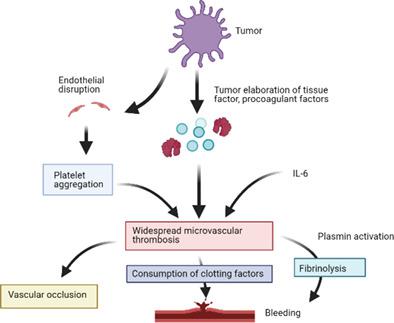当前位置:
X-MOL 学术
›
Thorac. Cancer
›
论文详情
Our official English website, www.x-mol.net, welcomes your feedback! (Note: you will need to create a separate account there.)
Disseminated intravascular coagulation complicating diagnosis of ROS1-mutant non-small cell lung cancer: A case report and literature review
Thoracic Cancer ( IF 2.9 ) Pub Date : 2021-07-22 , DOI: 10.1111/1759-7714.14071 Rachel Woodford 1, 2 , Michel Lu 2 , Nadine Beydoun 3, 4 , Wendy Cooper 5, 6, 7 , Qin Liu 8 , Jodi Lynch 2, 3 , Lawrence Kasherman 2, 3
Thoracic Cancer ( IF 2.9 ) Pub Date : 2021-07-22 , DOI: 10.1111/1759-7714.14071 Rachel Woodford 1, 2 , Michel Lu 2 , Nadine Beydoun 3, 4 , Wendy Cooper 5, 6, 7 , Qin Liu 8 , Jodi Lynch 2, 3 , Lawrence Kasherman 2, 3
Affiliation

|
Disseminated intravascular coagulation (DIC) is a rare paraneoplastic complication in advanced solid malignancies, with success of treatment and survival dependent on treatment of the underlying malignancy. Best estimates suggest an incidence of 1.6–6.8% in cancer, with risk factors being advanced disease, older age, and adenocarcinoma, especially of lung origin. Few cases, however, have reported on an association between DIC and oncogene-addicted lung cancers, especially those containing ROS proto-oncogene 1 (ROS1) mutations, however precedent exists to suggest increased prothrombotic rates in tumors harboring this mutation. We present a young woman with ROS1-mutant non-small-cell lung cancer who presented in DIC and subsequently developed complications of both hemorrhage and thrombosis. Following initiation of targeted treatment, rapid resolution of laboratory coagulation derangement was observed and clinical improvement quickly followed. This event underscores the need for rapid evaluation of lung molecular panels and the dramatic resolution of life-threatening illness that can occur with institution of appropriate therapy. This case contributes to growing evidence for a possible underlying link between oncogene addicted tumors and abnormalities of coagulation.
中文翻译:

ROS1突变非小细胞肺癌诊断的弥漫性血管内凝血一例报告及文献复习
弥散性血管内凝血 (DIC) 是晚期实体恶性肿瘤中罕见的副肿瘤并发症,治疗的成功和生存取决于潜在恶性肿瘤的治疗。最佳估计表明癌症的发病率为 1.6-6.8%,危险因素是疾病晚期、年龄较大和腺癌,尤其是肺源性癌。然而,很少有病例报道 DIC 与致癌基因成瘾性肺癌之间的关联,尤其是那些含有 ROS 原癌基因 1 ( ROS1 ) 突变的肺癌,但已有先例表明含有这种突变的肿瘤的促血栓形成率增加。我们向一位年轻女性介绍 ROS1-在DIC中出现并随后出现出血和血栓形成并发症的突变非小细胞肺癌。在开始靶向治疗后,观察到实验室凝血紊乱的快速消退和临床改善迅速。这一事件强调了对肺分子组进行快速评估的必要性,以及通过适当的治疗可以显着解决危及生命的疾病。该病例有助于越来越多的证据表明致癌基因成瘾性肿瘤与凝血异常之间可能存在潜在联系。
更新日期:2021-09-02
中文翻译:

ROS1突变非小细胞肺癌诊断的弥漫性血管内凝血一例报告及文献复习
弥散性血管内凝血 (DIC) 是晚期实体恶性肿瘤中罕见的副肿瘤并发症,治疗的成功和生存取决于潜在恶性肿瘤的治疗。最佳估计表明癌症的发病率为 1.6-6.8%,危险因素是疾病晚期、年龄较大和腺癌,尤其是肺源性癌。然而,很少有病例报道 DIC 与致癌基因成瘾性肺癌之间的关联,尤其是那些含有 ROS 原癌基因 1 ( ROS1 ) 突变的肺癌,但已有先例表明含有这种突变的肿瘤的促血栓形成率增加。我们向一位年轻女性介绍 ROS1-在DIC中出现并随后出现出血和血栓形成并发症的突变非小细胞肺癌。在开始靶向治疗后,观察到实验室凝血紊乱的快速消退和临床改善迅速。这一事件强调了对肺分子组进行快速评估的必要性,以及通过适当的治疗可以显着解决危及生命的疾病。该病例有助于越来越多的证据表明致癌基因成瘾性肿瘤与凝血异常之间可能存在潜在联系。



























 京公网安备 11010802027423号
京公网安备 11010802027423号